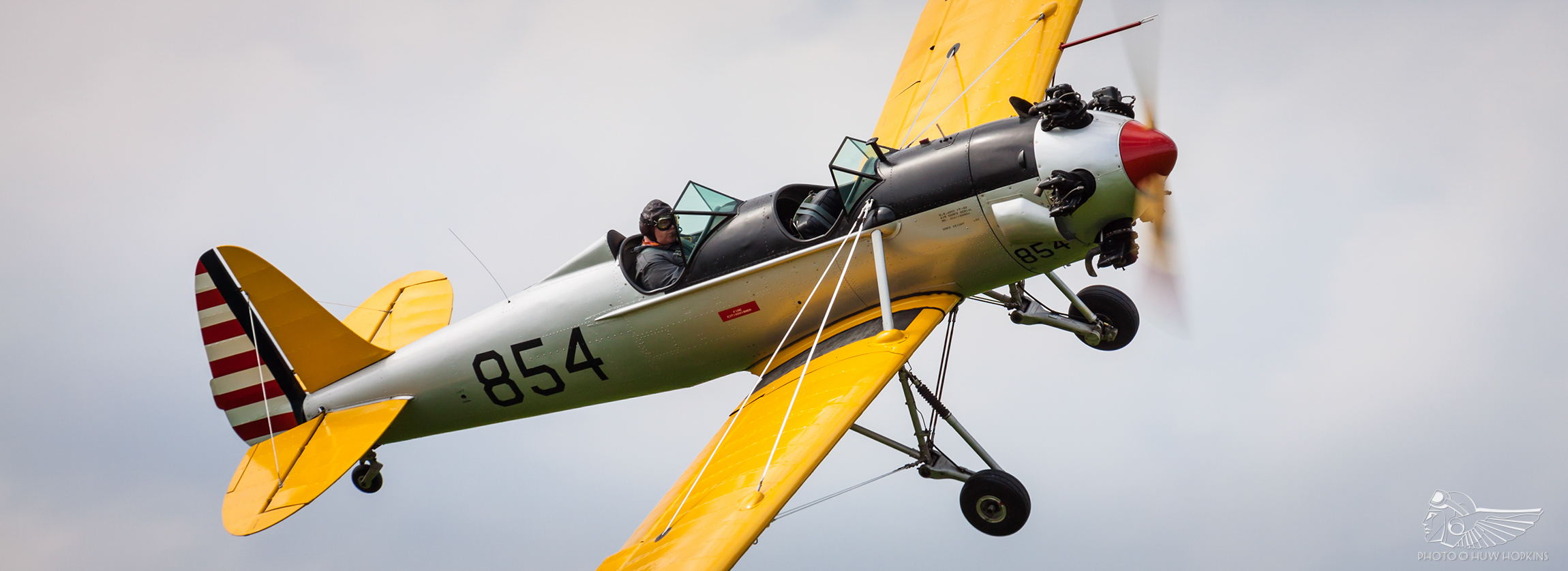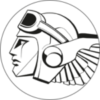The Radial – I have to admit to having rather a passion for these smoke belching specialist aeronautical mechanical devices. The engine is always the heart of any aircraft but the radial seems even more than that, it defines the aircraft whether it be the profile to accommodate the frontal area, the invariable oil leaks (or marking its territory as we say!) or the way it starts in clouds of smoke and its distinctive sound.
Through aviation history there have been two schools of thought on engine design – inline or circular – and there have been a whole raft of variations on these two themes. In the circular school, the rotary engine was the early standard where the crankshaft was bolted to the airframe and it was the engine that rotated, to which the propeller was fixed. This had many advantages including the engine itself acting as the flywheel, rather than having to add the mass of one, as well as the cooling effect of the engine spinning, even when on the ground. However, there were downsides including the gyroscopic effects on handling (Sopwith Camel trainee pilots were not allowed to turn right unless above 1,000 feet initially) and a limitation on the ultimate power of these designs. The Bentley BR2 (as used in the Sopwith Snipe) perhaps represents the pinnacle of rotary development, peaking at 245 bhp.
The inline engine favoured over 100 years ago by the Wright brothers, who designed and built their own, often had to be water-cooled because sufficient airflow could not be easily routed around the cylinders for that purpose. The horizontally opposed engines from the 1940s and ’50s managed to do away with the necessity of water cooling but as designers and operators know, baffle and cowling design is a bit of a black art to get front and rear cylinder temperatures even.
The successor to the rotary was the radial, where the engine is fixed and the propeller is driven by the crankshaft through the wonderful contrivance of the master rod and main journal, with each of the other slave connecting rods (conrods) contributing to the whole endeavour. It is worth having a look at the animations that demonstrate this intriguing choreography of a seemingly illogical design. This in an instant resolved the handling issues and also removed the power limitations. There were other benefits such as the oil no longer being slung into the airstream and hence back onto the pilot. The lubricant, often being castor oil, was prone to cause digestive complications for the air crew! As most rotary engines tended to utilise a total loss lubrication system, oil consumption and hence flight limitations were also improved.
Although oil consumption was greatly improved over the rotary, usage and therefore the need for replenishment was a factor in some scenarios. The Skyraider’s patrol and loiter profiles, for example, meant that a very large oil tank of 36 gallons was required for its missions of up to ten hours and it was oil rather than fuel which could be the limiting factor. The piston airliners of the 1950s had flight engineers to not only manage the engines, frequently adjusting mixtures, but also to monitor oil usage and pump oil from a reserve tank to the appropriate engine.
The design rules of the four-stroke cycle dictate that a radial engine must have an odd number of cylinders. Louis Bleriot made use of all 24hp of the three cylinder Anzani to cross the Channel in 1909, an example of which at the Shuttleworth Collection is thought to be the oldest airworthy aero engine in the world. Engines like the Warner Scarab and Kinner, popular in the boom in personal aircraft before World War Two, have five cylinders and produce up to 160 bhp whilst the seven cylinder Continentals and Lycomings often seen in Stearman produce around 220 bhp, giving rise to the aircraft’s curvature of the earth departure climb!
The ubiquitous Pratt and Whitney Wasp produces up to 600 bhp from its nine pots and was my first introduction to radials in the Harvard. The ultimate nine cylinder radial is the Wright Cyclone (producing 1,425 bhp) that had great success in the Flying Fortress and many crews owe their lives to the ability of this engine to sustain damage but keep running for hours. It was also eventually used in the T-28 trainer to good effect. This was conceived as a replacement trainer for the Harvard but equipped with a “low powered” radial of 800hp to give pilots experience of the slow response of the jet they were moving onto.
The Wright Cyclone gave the aircraft a new lease of life, seeing much active service. However, this is not the limit for radial engines as designers added another row of cylinders behind to create multi-row configurations. Up to four row engines have been developed but the cooling of the rear cylinders is an increasing challenge. There have even been designs with eleven cylinders in each row but this level of complexity has not seen great success.
One of the power limitations of the radial concept is the valve gear and a further attempt to address this was the sleeve valve, a concept as fascinating and complex as the radial master and slave conrods. An elegant design, but one requiring high levels of engineering accuracy to build and notoriously difficult to maintain. This ultimate development of the radial is perhaps characterised in the Bristol Centaurus two row, 18 cylinder design producing close to 3,000 bhp in its most powerful guise. This can be witnessed in the Hawker Sea Fury, Britain’s ultimate piston fighter, where the Centaurus delivers 2,480 bhp.
The most important difference in pre-flight preparation of a radial engine is the ritual of “pulling through”. This procedure is required as oil can drain into the lower cylinders and, if not cleared, can result in a hydraulic lock which can bend the conrod causing eventual engine failure. Pulling through of the prop in the normal direction of operation removes this oil. A good tip is to pull the prop through the same number of blades as there are cylinders, plus one.
Care must be taken to monitor the force required, as damage can still be caused if there is a lot of oil causing a lock due to the leverage that can be applied. In these cases the lower spark plugs must be removed to allow the oil to drain out before attempting a start. On very large radials, the clearing of oil is achieved by motoring the engine over on the starter which has a clutch to limit the force in the case of a lock. However, there will always be a small amount of oil remaining to cause the distinctive smoky starts!
A good example of the starting process is that for the Harvard. After the pulling through process has been performed as part of the pre-start checks which include setting the throttle and mixture, the wobble pump needs to be operated to pressurise the fuel line. Then priming of the engine is required, usually needing four to six shots of the priming plunger (each engine is slightly different) whilst still using the wobble pump to maintain fuel pressure. Then with another shot of prime ready to use, the starter needs to be engaged. Various starter systems have been used on Harvards including inertia flywheels and the Coffman cartridge but an electrical starter is now fitted to most. This is operated by either a guarded switch or a foot plate switch ahead of the stick. The latter at least frees up a hand. Holding the stick back (need another hand!) the starter is energised and after five blades have passed, the mags are selected to ‘on’.
During the process fuel pressure needs to be maintained via the wobble pump and another shot of prime pumped in if the engine falters. As most pilots have only two hands, one can be freed up by holding the stick back by hooking it with your leg. The term “one-armed paper hanger” often comes to mind at this time! Throttle position is very critical to both ensure starting but also minimise back fires. Too high a throttle setting needs to be avoided for that reason and this is further exacerbated if the engine has been shut down (as it should at the end of flying) with the prop set to coarse. This removes oil from the prop mechanism but unfortunately means there is more load impeding the start of a cold engine.
As the engine start continues the wobble pump and primer still need to be used as required until the engine is running smoothly, all the time looking out for flames from a back fire or over priming. Cranking of the starter should be continued to suck the flames into the engine.
As the clouds of smoke blow past the cockpit while the excess oil in the cylinders is burnt off, that distinctive radial rumble provides the aural delight which is part of the pleasure of operating a radial engine. The usual after-starting checks are made but due to larger quantity of oil involved in a radial engine, a long period is normally required for it to properly warm.
Engine handling needs to follow the usual good practices with smooth inputs with an important additional factor; never let the prop drive the engine, i.e. don’t reduce power below a point where air flow pushes the prop round, turning the engine. This is because the position of the oil feed entry to the main journal is designed to be away from the side under load when the engine drives the prop. When reverse is the case, oil flow is greatly impeded on the main journal, which is never good for any engine.
Due to their large frontal area, radial aircraft tend to have longer propellers, much like the rotaries, to reach out to a cleaner airflow. However, due to the higher rpm of the radial, those without geared-down props achieve high speeds at the prop tips and in the case of the Harvard, the tips go supersonic at over 2,200 rpm, giving them their distinctive prop sound.
World War Two represented the pinnacle of piston aero engine development with Britain initially employing a dual strategy of inline engines for fighters and radial engines for bombers. There were a number of technical and logistical reasons for this but eventually the Merlin (and later Griffon) dominated.
In combat the radial engine still had a distinct advantage taking, and surviving, battle damage. A water-cooled engine often only lasted a few minutes after being hit and fire was a frequent result of the failure. However, radial engines have a remarkable history of suffering major damage but continuing to operate for extended periods. Radials have continued to operate even having lost complete cylinders or all of their oil. In the latter case, as long as power is not reduced, the engine will continue to run, possibly up to an hour with the white metal of the main bearing providing sufficient lubrication.
There have been countless examples in the US Army Air Force’s daylight raids where badly damaged radials lasted long enough to give their crews a chance. In the civilian world post-World War Two, there have been examples of multi-engine commercial operations where a radial engine has suffered major damage without the crew being aware until they have spotted an errant cylinder punched through the engine cowling.
So, the radial engine is one with great character, great history and remarkable endurance, but an engine that needs to be handled correctly. Something to remember as you dodge the oil it has spilt on the hangar floor or as it rumbles past!
![]()












